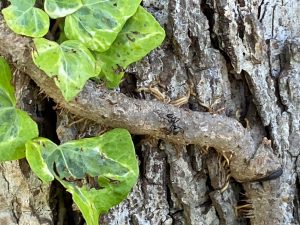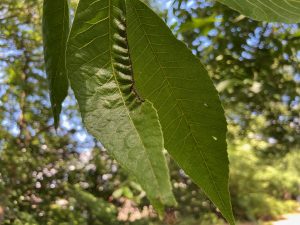Ecological Methods: Field Sampling Techniques
 |
 |
 |
 |
 |
Life on a Pecan Tree (Carya illinoinensis) ©P. Aune 2020
Ecology Lab Report
Now that you have spent 2 Lab Units studying trees and the plants, fungi and animals around them, we want you to consolidate your findings by writing a Laboratory Report. Follow the proper Lab Report format discussed in lab Unit 2 Discovery and the Scientific Method weeks I & II and Lab 4.2. You can choose to write this lab report on either Unit 4.1 Leaf Herbivory or on Unit 4.2 Urban Ecology. This report is to be written individually with the focus on your Group data for Unit 4.1 or your own data for Unit 4.2, though you should also include data tables, graphs, trends from the group work completed during your IN-LAB sessions for the ecology labs. You may also choose to focus on another aspect of the group data or of you own data not presented by your group in lab.
- When you include group data, you will need to cite it in text and include it in the references list. For example, an in-text citation would look like: (Group 1, 005A 2022).
- A reference list citation would look like: Group 1, 005A. 2022. Leaf Herbivory (or Urban Ecology), Biology 181 Laboratory, Biological Sciences, NC State University.
- NOTE: Your group work does not count as primary literature sources. Even though they cite original work, this has not been reviewed by other scientists and published.
| We will not do peer reviews of these papers, like we did for the Foraging Papers at the end of Lab 4.2, but you can certainly do this on your own with others in the lab using the provided Ecology Lab Report rubric on the Assignment page. |
| Final report due in Moodle using Turn It In*, Apr. 3-7, 2023 (55 pts). |
Lab Report Criteria:
All reports must be typed, double spaced, and include at least two primary literature references and the lab manual. Additional primary or secondary references are fine. These papers are generally 4-6 pages in length.
Tables and Figures to include:
- All relevant tables, summary tables (?), and graphs of the field data. Include data as needed to support your work. Though we did not make graphs for the Urban Ecology Lab during our In-Lab class, students should produce graph(s) to help summarize main data trends.
- Photographs for the qualitative data part of your work.
- Label all figures, tables, images correctly and refer to them in your text.
*NOTE: When you upload your written work on Moodle for the lab report, it will interface with “Turn It In,” a writing support application. You will be able to get automatic feedback using the e-rater Results (spelling and grammar checks) and check the originality/similarity report of your writing. You can make corrections based on this feedback. Papers may only be resubmitted once before the final due date. This is a great tool for writers!
Ecology Lab Report grading rubric – We will not do peer reviews in lab for this report, but you can certainly do this on your own with other students in the lab.
- Print copy of the Ecology Lab Report description.
Resources for Help in Writing your Lab Report:
- Check out the Links on the Resources page on the Lab Website.
- Inside-Out-Approach to Writing Lab Reports(opens in new window)
- LabWrite Home(opens in new window)
- LabWrite Postlab – Standard lab report (hypotheses-driven)
- View sample lab reports –look at formatting AND how references are used and cited.
- Guide to Analyzing Sections of a Lab Report(opens in new window)
- PPT that shows common mistakes with plagiarism(opens in new window)
- PowerPoint from a Workshop on Writing Lab Reports(opens in new window)
- (PPT tells you the basics, but also addresses common mistakes and questions from past students.)
- Writing tips for Scientific Writing(opens in new window) (Active/Passive Voice, Wordiness, References, Pronouns, Tense Issues, Syntax)
- Lab Unit 2 scroll down for a variety of resources found under Written Scientific Communication.
- 8th Edition CSE Scientific Style and Format Citation Quick Guide –new link! This shows in-text citations and how to write out the full reference for a variety of sources (journal articles, electronic journals, books, web pages, conference papers…)
- Scroll down to see how to reference different types of materials you may use in your report: Journals, Books, Websites and Other Online Materials
- CBE/CSE Handout – an updated handout based upon the 8th Edition above.
